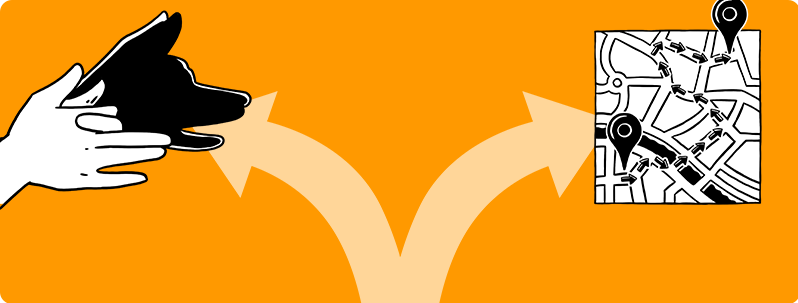How to think like a designer: solving problems with creative design
Written by Maren Dinges | 28th August 2024

Table of Contents
Design thinking isn’t just about being creative; it’s a powerful approach to problem-solving and innovation. At its core, design thinking means bringing together diverse teams who step into the shoes of their target audience. The goal? To tackle problems in a way that’s both creative and centered on the user.
In this article, we’ll explore what design thinking is and the methods you can use at each stage of the process.
What is Design Thinking?
Design thinking is an agile problem-solving framework that uses iterative processes. It focuses on understanding and addressing the needs of users throughout the problem-solving journey.
Design thinking isn’t just about finding quick solutions; it’s about addressing existing problems with a user-focused approach. The method is both creative and experimental but follows a systematic five-step process:
1. Understand and observe
2. Define
3. Generate ideas
4. Build prototypes
5. Test and learn
This makes design thinking a strategic and creative tool throughout every stage of the process.
Multidisciplinary teams intentionally use design thinking to consider user perspectives early on in the development, improvement, or refinement of products and services. According to design thinking principles, the best solutions are those that are technically feasible, economically viable, and most importantly, humanly desirable.

Step by Step: From Idea to Solution
For example, a software developer like Jan might use design thinking to program, test, and enhance software.
But that’s just one example. The applications of design thinking are broad:
- Product Development: Designing and improving products
- Usability: Developing and optimizing services
- Strategy Development: Creating and refining business models
- Education: Designing learning environments and tackling social challenges
- Organizational Development: Shaping corporate culture and benefits
- Marketing: Developing and launching campaigns
Let’s walk through the five phases of the design thinking process with Jan and his team.
Step 1: Understand and Observe
In the first step, Jan, the software developer, examines the users of the software:
- Who is the target audience?
- What do the users want?
- What needs does the software meet for them?
- What goals do they have when using the software?
Jan looks at the target audience from every angle. He gains fresh insights by observing users and understanding how they interact with similar products. His first step is to review feedback, service tickets, and opinions on review websites. Jan and his team then take action, examining the software interface from the user’s perspective. The aim is to gain a deep psychological understanding of the target audience and develop empathy for them.
Jan can also gather new data through surveys to better understand the target audience and sharpen his awareness of the problem.
Step 2: Define
In the second phase, Jan defines the user’s problem. He and the project team prepare materials, data, survey results, and other information to make it easy to understand, ideally in a visual format. To do this, Jan creates a video using the simpleshow video maker in just a few clicks. The video clearly defines and systematically presents the problem: Jan’s users are frustrated because they can’t access their data on the go.

Step 3: Generate Ideas
Now that Jan understands the user’s problem, he and his team brainstorm ideas to solve it. In the first stage, all ideas are welcome. Then, they evaluate which ideas are economically feasible, practical to implement, and desired by users. Jan and his team come up with the idea of making the software available as an app.
Step 4: Build Prototypes
Next, Jan builds a prototype. Using a mock-up, he creates the first functional version of the product. The goal here isn’t to create a perfect product but to develop the app interface enough to gather feedback from users.
Based on this feedback, Jan quickly identifies which features are popular and where there’s room for improvement. This gives him all the information he needs to program the app to meet user needs and preferences.
Step 5: Test and Learn
Before launching, Jan and his team test the app through multiple cycles. He assembles a test group of users who repeatedly try out the new versions of the app.
This allows him to gather up-to-date feedback to finalize the app and learn even more about the target audience.
How many cycles Jan and his team go through depends on the app’s success. They may even decide to scrap the app and restart the design thinking process from the beginning to come up with a better solution.

Two Practical Design Thinking Methods
The design thinking process remains consistent, but the methods used in each phase can vary from project to project.
Here are two popular creativity techniques:
Shadowing
Shadowing helps you gain a deeper understanding of your target audience. You follow them in their natural environment, observing their daily tasks and the challenges they face. This provides a comprehensive picture of the context in which your target audience interacts with your product or service.
As a qualitative research method, shadowing includes the following elements:
- Clearly define your objectives
- Select representative individuals from your target group
- Transparently explain the purpose of shadowing to participants
- Document their activities, interactions, problems, and challenges
User Journey Mapping
User journey mapping visualizes the entire user experience with your product or service. This method helps you identify the touchpoints where your target audience interacts with your solution and where drop-offs occur. Ideally, you should create a user journey map for each persona. This allows you to refine your target audience and pinpoint the exact pain points and desires of each persona.
Videos are an excellent way to visualize each persona’s journey. They guide you through various touchpoints, providing a clear picture of the persona. The simpleshow video maker can assist you in this process. Choose illustrations that best represent your persona, or upload your own images. This helps you quickly create memorable visuals.
Conclusion: Unlock Your Creative Potential with Design Thinking
Design thinking is dynamic, creative, strategic, and experimental. Companies use this method to creatively solve complex problems. Videos can be helpful in every phase of the design thinking process: they present results, showcase your target audience’s journey within your company’s world, and bring personas to life.
simpleshow video maker offers you a variety of options for explaining design thinking or creatively illustrating its phases. It’s quick and easy: upload your findings and documentation with one click, and the simplifier will summarize the key messages into a video script. All you need to do is select the appropriate illustrations, and your video is ready! Dive into design thinking and start creating innovation.


